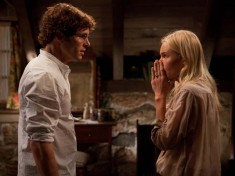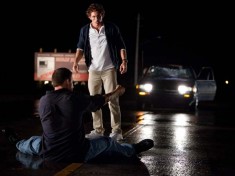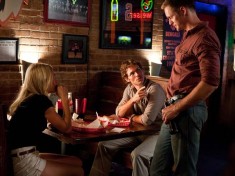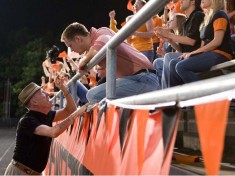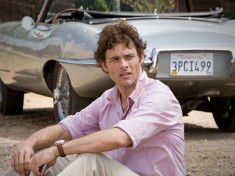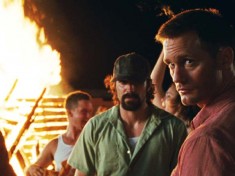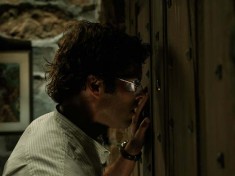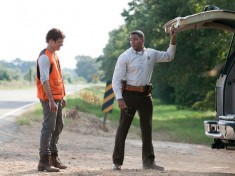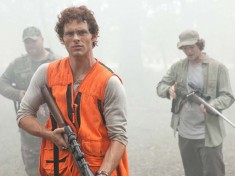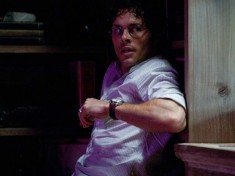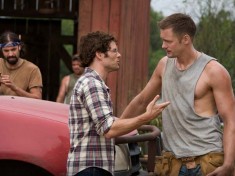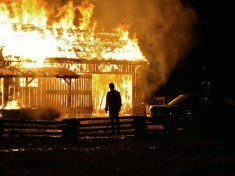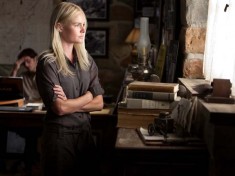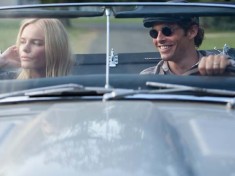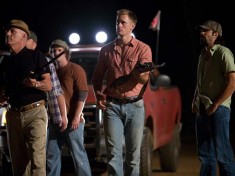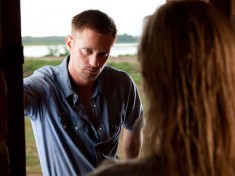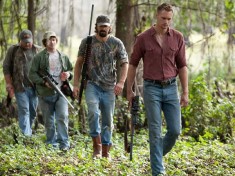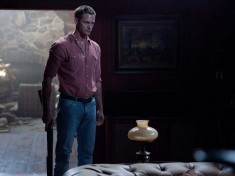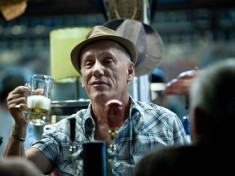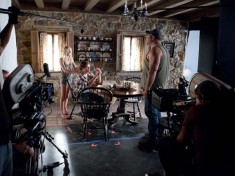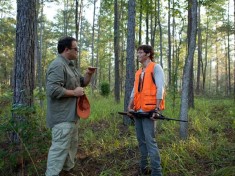Straw Dogs Pics and Production Notes
The original 1971 Sam Peckinpah Straw Dogs is a classic of revenge cinema, his first non-Western movie. It will be interesting to see how the 2011 remake deals with the issues of misogyny and gender roles in the film, which is an even more difficult area to navigate now than it was in the 1970’s.
STRAW DOGS: Taken from the classic Chinese text, Tao Te Ching, likening the human condition to that of an ancient Chinese ceremonial straw dog. The dogs, which were made from straw, were used as offering to gods in ancient Chinese rituals and treated with the utmost reverence, only to be trampled on and tossed aside when no longer needed.
When everything you’ve lived for is under siege, what would you do?
How far would you go?
It’s a question made terrifyingly apparent to Hollywood screenwriter David Sumner (James Marsden) and his actress wife Amy (Kate Bosworth) when they move to her small hometown in the Deep South after her father’s death. Smiling faces, warm welcomes and what were once comfortable old relationships take on a sinister tinge for David and Amy, who find themselves driven to a crisis-laden brink in Screen Gems’ frightening reimagining of the classic 1971 film “Straw Dogs.”
The suspenseful, gut-wrenching and intensely cathartic new version brings the original story to the present-day American South, and sets it against a backdrop of small town life where everyone knows too much about each other, the town hierarchy is determined by your place within the ranks of the high school football team and the performance of the football team at Friday night’s game determines the fates of many.
David and Amy’s plan is to prepare for sale the family home, which has fallen into disrepair, and for David to take advantage of the quiet and solitude to complete the screenplay he’s working on.
But all is not as bucolic as it seems in Blackwater, Mississippi, and the arrival of the Sumners stirs up long-dormant resentments and suspicious actions. Once there, Amy slips back into being the hometown celebrity, which leaves David feeling out of touch with his wife and questioning her behavior. Meanwhile, tensions build in their marriage and old conflicts re-emerge with the locals, most notably with Amy’s ex-boyfriend Charlie (Alexander Skarsgård), who, along with his fellow former football teammates Bic (Drew Powell), Norman (Rhys Coiro) and Chris (Billy Lush) push the limits of David’s tolerance and the Sumners’ marriage, forcing them to re-evaluate each other and their relationship.
When the daughter of the former football coach Tom Heddon (James Woods) goes missing, her father takes the law into his own hands, enlisting Charlie and his boys to help him search for her and setting into motion a series of events that ultimately leads to an explosively violent confrontation, escalating to a shocking, catastrophic climax that will shatter the lives of everyone involved.
The 1971 release starred Dustin Hoffman and Susan George and was written and directed by Sam Peckinpah. David Zaleg Goodman also has a writing credit on the original’s screenplay and both films are based on the book, The Siege at Trencher’s Farm by Gordon Williams.
Screen Gems presents a Battleplan Production, STRAW DOGS, starring James Marsden, Kate Bosworth, Alexander Skarsgård, Dominic Purcell, Laz Alonso, Willa Holland, and James Woods. Directed by and screenplay by Rod Lurie. Marc Frydman produced. Based on the ABC Motion Picture Screenplay by David Zelag Goodman and Sam Peckinpah. Based on the novel “The Siege of Trencher’s Farm” by Gordon Williams. Executive Producers are Beau Marks and Gilbert Dumontet. The behind-the-scenes team includes director of photography Alik Sakharov, ASC, production designer Tony Fanning, and editor Sarah Boyd, A.C.E. The music is by Larry Groupé and costume designer was Lynn Falconer.
STRAW DOGS has been rated R by the MPAA for the following reasons: strong brutal violence including a sexual attack, menace, some sexual content, and pervasive language. The running time is 109 minutes.WHERE MACHISMO RULES
When director/screenwriter Rod Lurie and his producing partner Marc Frydman set about the task of revisiting Sam Peckinpah’s controversial 1971 film Straw Dogs, foremost in their minds was capturing the scary intensity of the story and its exploration of the darkest human behavior, but also reconfiguring its horrific contours for the realities and moviegoing sensibilities of a new generation.
“Peckinpah had a very definite point of view of human beings and how they behaved,” says Lurie, of the original film’s shocking violence. “He was very much a pessimist about human beings, and I believe I’m an optimist. So I thought it might be an interesting experiment to see whether or not you can do the same story, but tell it from a different point of view.”
Working more from Gordon William’s novel, The Siege of Trencher’s Farm than from Peckinpah’s film, Lurie felt that updating the story and bringing its special psychological terror into the classic American setting of a small Southern town — where life was ruled by how the football team performed on Friday night and the townspeople’s roles were a clearly defined hierarchy — would bring a modern edge to what is at heart a powerful and ultimately terrifying examination of a relationship being incomprehensibly tested and torn apart.
Recalled Marc Frydman, Lurie’s partner at Battleplan Productions, “Rod and I had been discussing ‘Straw Dogs’ since we first started working together over 10 years ago. Then while we were under contract at ABC we realized that a subsidiary of the company that had been active in the 70’s, but had since folded, ABC Pictures, still held the option on the project. I contacted the person handling the rights and told them that the second it became available I’d have a check to them.”
Rights in hand, Lurie then set about regrounding everything in William’s novel, shifting the location to a small fictional Southern town steeped in traditions of brutality, and transforming the characters into roles within that classic American setting.
“It’s not so much that it’s the South,” explains Lurie. “What I wanted to define was a culture where violence was a part of their everyday life, where they’re hunting, where there’s football – which I adore – and where their people solve things through fights. Where machismo rules.”
Continued Frydman, ”Rod felt strongly that one of the reason’s the original film didn’t really work in the States was because it was set in England. By relocating the setting to a Southern football culture and transferring the characters to players in a small town ruled by that culture, it provided a background and familiar setting that we felt was missing from the original. Rod and I both felt that we weren’t remaking Peckinpah, we were retelling the story.”
The southern location also provided the background for the hot and sweaty atmosphere that Lurie wanted to bring to the film, and which came to life when Screen Gems’ president Clint Culpepper suggested shooting the film in Shreveport, Louisiana. “Clint knew that we wanted a heavy, intense feel for the movie and had previously shot movies there and suggested it as a perfect set-up for the shoot,” recalled Frydman. “After a scouting trip down there we knew we had found our Blackwater and other than dealing with rain issues it really was the perfect setting and provided the exact feel and look we were striving for in updating the story.”
One thing Lurie and Frydman agreed should not change, was the central core of the story’s menacing buildup, which forces a reluctant hero to use violence in order to defend his wife, his property and both of their lives – and whether after being shattered, his marriage could ever be rebuilt. But it begins with a seemingly happy union.
“This is a couple at the nascent state of their marriage, where they’re making an assumption that everything is okay,” offers Lurie, who modernized the marriage by making Amy Sumner a working woman, in this case an actress, and her husband David – a math professor in Peckinpah’s version – a Hollywood screenwriter. “They’ve probably lived their entire relationship both working and not spending that much time together. And now they’re beginning to learn the hard truths of their marriage, and it doesn’t help that they’ve come into a world where her old boyfriend also exists.”
Stepping into the roles of Amy and David are two of Hollywood’s rapidly rising stars – James Marsden and Kate Bosworth.
For Marsden, who had most recently been seen on screen in much lighter roles, the script struck a chord with him. “When I read the script for the first time, I imagined the whole thing in my head. It felt like something I could contribute to,” he remembers.
Lurie knew exactly what Marsden could contribute: a performance completely different from Dustin Hoffman’s. “Instead of going for a New York Jewish intellectual, I went for a sort of Greenwich, Connecticut country club sort of intellectual, and that’s what Jimmy brought. And it was very freeing for all of us, because we were not at all beholden to anything Hoffman had ever done. He’s one of the most talented people I’ve ever met in my life.”
Bosworth also had a strong reaction after reading Lurie’s script. “I had never seen the original film and I read the script before watching it and thought it was really interesting. I’m always drawn to character relationships and the complexities that exist there and this story is rich with them.” Laughing, she adds “Then I rented the original and was immediately terrified.”
Easing that trepidation was the chance to rehearse for two weeks with Lurie before production began. “It was a great luxury to just throw out ideas and talk about the differences between the films,” recalls Marsden. “We really explored, and continued to explore while we were shooting, the dynamic between David and Amy – their marriage, the problems with their marriage, where they came from and where they’re at in their lives. Rod was really great throughout the rehearsals and the shoot with giving us the room to move around a bit and find things. We had a certain amount of creative license to find the characters ourselves and make them our own.”
Adds Bosworth, “Rod had to gain a real kind of trust with me to be able to go to certain places and be courageous with certain things and learn the extent to which I’ll go. It was that sort of creating – talking about trust, experiencing this together and knowing there is nothing too deep or far that will frighten me or take me out of the moment. I think we all had that mentality so the fear, in a way, was positive and fueled our performances. Hopefully that will show.”
Lurie says the trust went both ways with her and Bosworth. “I remember telling her, ‘Since I wrote the screenplay, I know the character better than you. But when we start shooting, you’re eventually going to know the character better than me, and I will question myself if you challenge me.’ Sure enough, a week into shooting, there was a piece of direction I had given her, and she said, ‘I think you’re wrong.’ I didn’t think I was wrong. But I trusted her, and it turned out that she was right.”
As the shoot got underway, the decision to film in Shreveport proved to be advantageous for reasons other than the inherent heat and humidity. As Marsden and Bosworth had learned when they had previously worked together on Superman, which filmed in Sydney, Australia, shooting a film at a distant location away from your everyday life immediately forges stronger connections amongst the cast. “This existence in the trenches together creates an intense bond,” says Bosworth. “We’d be out to dinner, having lunch, at a music festival and it was a constant conversation of the characters and the script and the film. It’s this inescapable existence which works so well.”
Alexander Skarsgård, cast in the role of Amy’s high school boyfriend Charlie Venner, agrees that being together on location is an absolute asset. “When you shoot in Los Angeles everyone has their families and friends close by so after a long day or on weekends you hang out with your loved ones. When you’re on location you really get to know people and it adds a lot of flavor to it – we play locals and I’ve never been to Louisiana before so it’s been great to be out here and getting a little flavor of the culture.”
Casting Skarsgård in the role of Charlie seemed an unusual choice. The son of actor Stellan Skarsgård, he grew up in Sweden and although an established actor in that country had only recently come to the attention of the American public. Recalled Frydman, “We had a long list of actors for the role and had seen Alex in “Generation Kill” as well as, of course “True Blood” but casting him in the Charlie role seemed a bit of a stretch – especially given that the role called for a decided Southern drawl and English was not his native language.”
However, when Frydman and Lurie met with him, Skarsgård managed to quell their concerns despite the pair’s initial reaction that in person his lanky, metrosexual, unaffected appearance was not what they were looking for. “Rod told him that the role would require him to work out and get in shape, to which he promptly laughed and told us that he was already in great shape. And took off his shirt to prove it.”
For Marsden, Bosworth and Skarsgård – and the rest of the cast – the rehearsal sessions and time together off the set would prove invaluable as they got deeper into the shoot and closer to filming some of the most difficult scenes – including the rape sequence and the final siege segments. For Marsden especially, the progression of the story also saw his character coming to the realization that he can’t use his intelligence alone to halt what will become a deadly march.
Lurie and Frydman knew that this was the key to getting the story right. “David is a guy who becomes a hero against his own grain,” remarked Frydman. “He’s not cut out for violence but has to step up to the plate. He’s an intellectual. Hoffman played it perfectly – even during the action you could see him thinking and Jimmy brings that same sense of gravitas to the role.”
Marsden says of David, “He’s romanticized this idea of coming back to Amy’s hometown and writing and being inspired by the surroundings and atmosphere. Even though she’s a little apprehensive, he’s excited to go back to where she’s from and find inspiration by living in this beautiful Civil War house in the middle of nowhere and writing on an old Remington typewriter. Sort of Faulkner it up. But he very quickly becomes a fish out of water and starts to feel out of place and threatened by these guys and Amy’s history with Charlie. The cracks in the glass start in that first scene at Blackie’s and then spider web throughout the rest of the film.”
For Bosworth, the Amy and David relationship is sweet but superficial. “Jimmy and I talked about this a little and came up with the thought that they had worked on this sort of bad television show, which haunts her throughout the film. People always bring it up and she just sort of cringes – but it’s where she and David met. He was a writer and she was an actress. They get married and have fun with each other but if it were to come down to how much they really know about each other I don’t think they’ve really scratched that surface yet, and then Charlie enters the scene and I think, for Amy, this is someone who knows her very well and has an understanding of her fears and her dreams – all those things that make up a person, which I think is very comforting for her.”
Lurie remembers Skarsgård telling him when they first met that he felt that Charlie was very much in love with Amy, which prompted Lurie to give the actor a unique way to think of the film. “I told him that I thought that from his point of view, that he should treat this movie like it’s a love story,” recalls Lurie. “That he’s definitely not the heavy. He’s been jilted. He is the better man who is going to get the girl. And I believe that for the first hour of the film, that people who watch the film are almost rooting for Charlie.”
Of course, any goodwill for Charlie dissipates quickly, which leads to one of the movie’s most grueling scenes for Bosworth to film. But in the lead-up to shooting it, Bosworth learned that Lurie had arranged for her a telephone call with Susan George, the actress who played Amy in the original film. Their talk was a highlight for Bosworth. “It was an amazing conversation in that I really didn’t know what it would be like going into it. I almost felt like we would swap a few stories and say, ‘oh isn’t this weird that we’re both doing this.’ But I didn’t realize the depth that we’d both go to in the conversation and we had this rather strange, immediate connection when we realized that we’re the only people in the world who know what each of us went through.”
Bosworth continues, “Rod has been just extraordinary in creating this collaboration and allowing us to find our characters and relationships. I think the most challenging thing for everybody has been to gauge the tension because there’s been a kind of steady build even though we shot out of sequence. This film, these friendships and characters are something I’m going to look back on reflect on for the rest of my life, and during our conversation, Susan alluded to the fact that shooting the film was a very defining time in her life and that she looks back on ‘Straw Dogs’ not as Amy, but as a chapter in Susan George’s life that was defining to her. And I feel the exact same way. It’s been incredible.”HEROES WITH AN EXPIRATION DATE
When David and Amy first arrive in Blackwater, that romantic vision of David’s is shaken somewhat by the appearance of Charlie and his three friends, Bic, Norman and Chris, who David later refers to as Straw Dogs, likening them to straw offerings that were worshipped in ancient Chinese ceremonies then tossed aside and trampled. Marsden laughs, “Great analogy but it’s a pretty arrogant thing to say.” He continues, “Peckinpah was quoted as saying that David is the heavy of the film – he’s the one who comes into their territory and starts pushing their buttons. And David is that guy, but in the end when he’s completely isolated from everyone else, the audience roots for him.”
For Skarsgård, the return of Amy and her husband stirs up a complicated mix of emotions in Charlie. “Back in high school Charlie and the boys were living the dream. Charlie was the quarterback of the team and the star. He was dating the cutest girl in school and his life was great – college, the NFL – he was going to be a huge star. He got a full scholarship to the University of Tennessee but got injured after a year and was back in Blackwater where the girlfriend had moved to California and his career was over. So those expectations the town had of him being the kid who was going to put Blackwater on the map never happened, which I think weighs on him, and then Amy comes back with this guy who is the complete opposite of Charlie – intellectual, skinny little guy with glasses from Hollywood who doesn’t work for a living. He writes scripts. Is that a job even? So, it’s tough for Charlie.”
Drew Powell, who plays Bic, says the analogy rings true. “I know exactly where these guys come from. I grew up in a small Indiana town where the highlight of entertainment is the football or basketball team and I’ve seen these guys in my hometown. Stars at eighteen on the front page of the paper, doing radio shows and everyone is talking about you and that was the highlight of your life and it never gets as good as it was for those four years of high school. That’s definitely the case for these four guys, and then to have Charlie come back, who was really the only one of us who had potential, well, if he can’t make it, we don’t have a prayer.”
Rhys Coiro, who plays Norman, says that his character views David and Amy coming back as threats to his big-fish-in-a-small-pond mentality. “This is his place, you know? This is his town. And he feels that he’s entitled to do what he pleases in his town.” It’s an aspect of Norman’s personality that Coiro brought instantly to his audition for the part. Says Lurie, “I had seen Rhys on ‘Entourage’ and was just so impressed with him as an actor, but he came in scary as hell into the audition room and won us over very, very quickly.”
For the role of Deputy John Burke, the filmmakers wanted an actor who could suggest familiarity with Blackwater ways but an understated restlessness when old friends lose their common sense. They found it in Laz Alonso. “We decided we wanted a young Paul Newman type to play the sheriff in the town. In the original film he’s sort of a very uptight character, and older. We wanted to go younger and hipper, and I really do believe Laz has got the qualities of Paul Newman. You absolutely can never take your eyes off him on the screen.”
Alonso says the idea of leaving town and coming back can also bring a more settled perspective. “Rod and I worked on developing John’s back story which is that he has a lot in common with Charlie and the boys – they all played football together – but he went to Iraq, he fought, and he came back a hero. So there is a type of respect for his authority. He’s the voice of reason and is the one guy who can look at them and say ‘Enough with this nonsense. We’re better than this.’ ” Alonso continues, “John, because he goes away to war, doesn’t experience the same level of loss for the glory days as the other guys. He comes back with more of a love and appreciation for life and is viewed as a hero. But Charlie, Norman, Bic and Chris are really heroes with an expiration date. The minute they graduated the next team came in and takes all the glory and they’re on the sidelines. No one ever really prepares you for that.”
As Lurie wove the characters into the fabric of small-town Southern life, the football parallel allowed him to provide background stories and relationships for the roles that he felt were missing in the Peckinpah film. Recalls Powell, “Bic is the only Straw Dog who is not in the original film. There are other characters but it’s not specifically Bic. So my take on Bic is that he’s the follower, I don’t know where he is on the totem pole. I feel like Chris is the bottom, Charlie is definitely the leader, he was the quarterback and as he goes, so go the rest of us. And Norman is the second, you know, whether he was the running back or received, he is the second and is aware of it.”
Also reframed is the role of Tom Heddon, who in the 1971 film doesn’t have much of a background other than being a bully, but here becomes what Marsden refers to as the first generation Straw Dog. “He’s the guy who was the all-important coach for the all-important high school football team that makes the cover of every newspaper.”
For Lurie and Frydman, there was only one actor in mind for the Tom Heddon role – James Woods. Frydman comments, “Both Rod and I are huge fans, and he’s actually friendly with Rod and was on our list when we were casting “The Contender” but it didn’t work out. When we were casting Heddon I had just seen some of Jimmy’s work in ‘Shark’ and was completely blown away and he is so amazing in the role of Tom – just swallows the scene and brings something different every take.”
Lurie adds, “What James Woods delivers is a classic James Woods performance, which is really a raging fire all its own.”
Woods relished the role and worked with Lurie to hone the scenes. Says the actor, “It’s a wonderful character and rather than just making him a nasty, vicious, drunken fool I think he’s a guy who once had a wonderful life and then all of a sudden, his life changed overnight when his wife died and things emerged in his personality that didn’t go the right way and now he’s one of those pathetic people who’s left over in life with nowhere to go. Except the bar at Blackie’s. He’s a straw dog as much as the boys are who left the team.”
The cast found the chance to work with Woods an exhilarating experience. “It’s just an honor to be with him and be around him,” says Coiro. “He sets the bar really high.” Known for his improvisation in scenes, Woods kept the cast on their toes delivering different lines and readings sometimes with every take. “I made a choice as an actor, and Rod like it, to make this character incredibly mercurial. Rod is one of those great writer-directors who is not married only to his words. If you can come up with something and he likes it, you can go with it.”
For Bosworth it brought back memories of working on one of her first films, Wonderland. “I remember working with Val (Kilmer) and he was the same with improvisation which was a great training ground for me. We would go way off page and kind of delve into territories that didn’t even exist, we were creating it on the fly and I love that.”
The consummate actor, Woods worked with the film’s costume designer Lynn Falconer, as well as hairdresser Larry Waggoner to fully flush out Heddon’s look. “The look is very important and I told both of them that I was thinking Tom Landry,” says Woods. “Short hair, the hat and tattoos. Very buttoned up, like a military guy – kind of tough, wiry and lean.”
For Alonso, that attention is key to the film. “There’s a constant history that’s woven into everybody’s interaction and everybody’s wanting to be respected in the story. The Straw Dogs want their old glory back. Coach has been dethroned and so he’s resorted to alcohol and any minute will yell at people like the good old days. I want to keep people in line. Amy just wants to come home and not be bothered and David, well it’s obvious the stuff he’s dealing with. There’s a lot of testosterone in this town – it feels like a big football locker room. And when Heddon’s daughter goes missing it’s the straw that breaks the camels back and sparks a chain reaction of violence and predatory behavior with people defending their tiny little plot of land, and in football only the strong survive. If you show any weakness, that’s it. You’re going down.”
Powell sums up the grim trajectory of “Straw Dogs”: “There are no real winners in this film. No one comes out unscathed and I think that’s been an interesting way to modernize it. Rod has taken these two different stereotypes – the Hollywood elite and the Southern man – who often are at odds anyway, and shown both of their weaknesses in this film.”
Adds Coiro, “It’s not going to end well.”FINDING BLACKWATER
By relocating the environment of “Straw Dogs” to the Deep South, Lurie and his crew fully embraced the high temperatures inherent to the locale, and imbued the film with colors and visuals invoking heat and fire.
Explains Lurie, “We used fire as a motif in this film because I like that Richard Nixon expression that the strongest steel must first go through the hottest fire, and that sort of explains what happens to David.”
Production designer Tony Fanning recalls Lurie citing Nixon’s quote, too, and agreed with its relevance to the story they were telling. “His reason for using that quote was that he felt that Amy and David go through this horrific experience to find out who they’re going to be on the other side, both individually and as a couple and he felt that most of the movie was about walking through different forms of fire.”
With that direction, Fanning and his art director John Goldsmith worked to incorporate a ‘hot’ palette into all of the sets. Fanning continues, “There’s a lot of red, orange and gold accents in the house – the tile roof, the red trim. Blackie’s Bar had some red in it. For the football team, Rod chose a Bengal Tiger as the mascot – so we had a bright orange and black combination. We try not to hit you over the head with it, but the color is there.”
Lurie also wanted those punches of color in actual smoke and fire which is reflected in a few ways throughout the film, including a particularly striking hunting scene that wasn’t originally scripted as it was shot.
“There’s a scene where David is out hunting with Charlie and the boys,” says Fanning. “They leave him out in the middle of nowhere and he comes across a buck in a burned out section of the forest. The way it came about was that we came across this area where all the trees had been clear-cut and fallen on the ground. Rod suggested burning it up and making it into a visually big scene, which we did and it became this really beautiful image.”
With the overall look of the film agreed upon, Fanning and his team started to develop the key sets – most importantly, the house that David and Amy are coming back to Blackwater to work on and which is a central location for much of the story. A key element of the original film was the stone house that Peckinpah used, which had a fortress feel that was further enhanced by the remoteness of the location. For this film both Lurie and the studio agreed that they also wanted the house to be stone but in this case in a more classic early American colonial style. “Rod describes it in the script as a structure that was used to house officers during the Civil War. So that was our starting point,” recalled Fanning.
Fanning and his team set about researching colonial forts as well as looking in the area of the South the film was being located in for examples of the type of architecture and look they were seeking. “We knew that we were definitely not doing the same look as the original movie because that had a very monochromatic, cold, harsh look, which is what Peckinpah was going for. We were in the deep south in the summer so were immediately dealing with more color, foliage and more life in general for the whole film, which I think allows you to become interested in the beauty of it and then be traumatized by the harshness of what is to follow.”
In addition to retaining the stone façade there was one other element of the original house that was carried over as well. As with Peckinpah’s location, which overlooked the English Channel, this house was also surrounded by water. “We were actually very lucky to find the site as it wasn’t our original choice,” recalled Fanning. “Our first site was actually an existing stone structure with a boathouse that was located on a lake. The boathouse had a red tile roof which Rod fell in love with, but the location ended up falling through and Stanley Pearce, our location manager, found the final location which actually turned out better because it’s surrounded on three sides by water.”
For Fanning, Goldsmith and Lurie the location was indeed ideal. Located along the Red River on a flat plane with large ponds, the house sits on a slight rise and has a sense of being completely isolated. “As soon as we had the location we started working on figuring out the relationship between the house and barn to the water and to the double outlay of trees that are on the road approaching the house,” recalled Goldsmith. “Once that was laid out the smaller elements became important – the bell, the flagpole, the birdhouse, the garden. They all became opportunities for this feel of the house having fallen into a state of disrepair with the death of Amy’s father and a hurricane in the recent past.”
For the barn, Fanning and Goldsmith approached the design as a foil to the stone structure of the house. “Amy tells David that her father built the barn, so we knew it was going to something that had to show, by its scale and materials, that it was done with a small crew,” said Fanning. Continues Goldsmith, “The interesting thing for us about the barn is that it offered a variety of states of destruction and reconstruction, especially the roof which was designed as a very traditional, almost iconic barn form but with damage from the hurricane was being rebuilt. It’s not stone with a ceramic roof, it’s vertical board siding with a wood shake roof and we worked with a set designer in Los Angeles with the framing and half-flat joints that imply that this would have been considered as it was being built.”
With the site and layout determined Fanning and Goldsmith’s crews set about constructing both the house and the barn. The decision was made to build only the exterior shell on location and construct the interior sets on a soundstage. Both sets were built simultaneously with the exterior being put together in large parts and transported to location and assembled. The stone exterior was manufactured by an outside company and then brought in and painted in a hue that mimicked the red clay that surrounds the site. With a tight pre-production schedule – which was frequently disrupted by rain – it still all managed to come together in just under eight weeks.
Once the exterior design was in place the interior then became a reflection of that look. Because of the early American design, which is very small, and the reference to being a Civil War-era fort, Fanning and Goldsmith worked with a very specific visual scheme. “We talked a lot about defensibility – that in the course of the story you sense that really strongly on the inside by those things on the outside,” said Goldsmith. “The iron shutters, the rifle portals, smaller windows that let in less light – it all lends itself to a very unique feel.”
Fanning continues, “We approached the interior décor with a very masculine outlook. My feeling about the movie in general is that it’s a very masculine movie and it’s about guarding your territory and claiming your turf. Keeping what’s yours, and really, in a lot of ways, there’s not a place for Amy in this house either. It really was her dad’s place and we tried not to put a lot of feminine touches in it so that it didn’t look like the mother had full control over the house.”
For additional locations the production team utilized existing structures in and around Shreveport, Louisiana where the film was shot. For Blackie’s, the bar where the townspeople gather, Fanning was thrilled to find a location in Shreveport that met all of his needs. “We needed a space that was split into two parts, one that could be the pool table area and one for eating and dining. The building we found, which housed a local bar and grill, was perfect and really caught our eye because the interior was painted red so it was already a perfect fit for our overall look.”
For Goldsmith, the Blackie’s location also fit ideally with the idea that this was the place where the locals go to relive their glory days, and to further add to that visual he dressed the space with football jerseys and photographs that support the idea of the team mentality. “The items on the walls in Blackie’s further illustrate that these people have grown up together and worked as a team and they still live in town together, which more than anything sets David off as the outsider.”
For both Goldsmith and Fanning the most sweetest discovery was the church used for the scenes that depict the service to bless the football team. Recalls Fanning, “That really was the perfect find. It was exactly what Rod and I had in mind – not too nice, just a very simple small town church in perfect condition inside and out.” Added Goldsmith, “We literally didn’t do anything to it – added some flowers and put a sign out front and it became the Blackwater Church. It was beautiful.”ABOUT THE CAST
JAMES MARSDEN (David Sumner) Having appeared in a wide range of films over the course of his still young career, James Marsden continues to carve out a distinctive place in Hollywood.
Currently, Marsden is filming the thriller, Loft, with Wentworth Miller, Eric Stonestreet and Karl Urban. An adaptation of the 2008 Belgian thriller, the film follows five friends who share a loft for their extramarital affairs begin to question one another after the body of an unknown woman is found in the property.
Marsden recently wrapped production on As Cool As I Am, written and directed by Max Mayer. The film, co-starring Claire Danes, is scheduled to be released in 2012. He is also set to star in Jack Schreier’s Robot & Frank starring Frank Langella and Susan Sarandon. Marsden will play one of Langella’s grown children who helps install a robot to care for his father.
Marsden was last seen in Universal/Illumination’s Hop. The film, directed by Tim Hill and co-starring Russell Brand and Hank Azaria was released in April 2011 where it ranked #1 at the box office opening weekend and went on to gross more than 180 million worldwide.
In 2010, Marsden appeared in Neil LaBute’s Death at a Funeral. He received a 2010 Teen Choice Award nomination for “Choice Movie: Scene Stealer (Male)” for his role as the boyfriend to Zoe Saldana’s character, who finds himself as a “fish out of water” at a family funeral. Previously, Marsden starred opposite Cameron Diaz in Richard Kelley’s psychological thriller, The Box. And in 2008, he appeared alongside Katherine Heigl in the box office hit 27 Dresses, a romantic comedy for Fox 2000 and Spyglass Entertainment.
In 2007, Marsden received rave reviews for his singing and dancing range in both the box-office smash Enchanted opposite Susan Sarandon, Amy Adams and Patrick Dempsey for Disney and in Adam Shankman’s box-office hit musical Hairspray opposite John Travolta, Queen Latifah, Michelle Pfeiffer and Christopher Walken. Marsden played Corny Collins, the host of the TV dance show.
Marsden was also seen in Superman Returns for director Bryan Singer as ‘Richard White,’ a new rival for the affections of ‘Lois Lane.’ Kevin Spacey, Kate Bosworth, Brandon Routh and Frank Langella also starred. Marsden’s additional, diverse film credits include Cyclops in the X-men trilogy, the Nick Cassavetes romantic drama The Notebook, Sex Drive, Disturbing Behavior, 10th and Wolf, and Sugar and Spice.
Marsden currently resides in Los Angeles with his wife and two children.KATE BOSWORTH (Amy Sumner) Kate Bosworth has made the seamless transition from a young Hollywood starlet to one of today’s leading ladies. She played the iconic ‘Lois Lane’ in Warner Bros. Superman Returns for director Bryan Singer and graced the screen in Kevin Spacey’s Beyond the Sea, where she portrayed screen icon ‘Sandra Dee’ opposite Spacey as Bobby Darin. Receiving rave reviews from critics, Dee herself gave a nod of approval for her portrayal as the ultimate golden girl.
Bosworth most recently starred in the action film The Warriors Way alongside Danny Huston and Geoffrey Rush. She also starred in Another Happy Day starring opposite Demi Moore and Ellen Barkin and the independent film Little Birds, both of which premiered at the 2011 Sundance Film Festival as well as the comedy L!fe Happens with Krysten Ritter, which just premiered at the 2011 Los Angeles Film Festival. She recently completed production on the thriller Black Rock where she stars alongside Lake Bell.
Her other recent credits include David Auburn’s drama The Girl in the Park opposite Sigourney Weaver and in Robert Luketic’s 21.
Most recognized for her strong-willed performance in John Stockwell’s hugely successful Blue Crush, Bosworth landed her first lead role after dedicating herself to a crash course in surfing. Contradicting the blonde surfer-girl image and showcasing her multidimensional range, Bosworth’s next project, the dark indie biopic Wonderland, had her portraying the real-life girlfriend of the late, infamous porn star John Holmes, played by Val Kilmer.
With this determination not to be type-cast, it is no surprise that Bosworth made another turn in her next film Win a Date with Tad Hamilton, Robert Luketic’s romantic comedy in which she starred opposite Topher Grace and Josh Duhamel. Critics dubbed her as America’s next sweetheart for her performance as a small town girl caught in a love triangle. Bosworth also made a cameo appearance in Bee Season as a Hari Krishna convert opposite Max Minghella, Richard Gere and Juliette Binoche.
While she made her feature film debut in Robert Redford’s film The Horse Whisperer at the age of 14, Bosworth made the decision early on to make education her priority—choosing parts that would accommodate her school schedule. While in high school, she starred in the WB’s hit summer series Young Americans and took a role in Jerry Bruckheimer’s Remember the Titans. Subsequent to her graduation, Bosworth starred in Roger Avary’s Rules of Attraction.ALEXANDER SKARSGÅRD (Charlie Venner) is quickly becoming one of the most sought-after actors in Hollywood. He began his acting career at the age of eight and worked steadily in films and on Swedish television. Skarsgård went on to study theatre at the Leeds Metropolitan University in the UK and at Marymount Manhattan College in New York. He returned to Sweden immediately following and appeared in a number of productions making him a star in his native country. A visit to Los Angeles landed him an a part in the hit comedy Zoolander (2001) where he starred alongside Ben Stiller and Will Ferrell.
Skarsgård returned home to Sweden to continue honing his acting skills with roles in film and theatrical productions including “Who’s Afraid of Virginia Woolf?” and “Bloody Wedding”. He also co-wrote and co-directed an award winning short, Att döda ett barn (To Kill a Child) (2003), which was shown at the Tribeca and Cannes Film Festivals.
His first big break in the US was with the HBO miniseries “Generation Kill” (2008). His portrayal of Marine Sgt. Brad “Iceman” Colbert astonished critics and audiences alike. Immediately following, Skarsgård was cast in the role of Eric Northman, a 1,000-year-old Viking vampire, on HBO’s hit series “True Blood” (2008), where he currently stars alongside Anna Paquin and Stephen Moyer. The show rode to success on quality scripts, great acting and the public’s obsession with the vampire genre. “True Blood” is currently shooting their fourth season and has been picked up for a fifth season.
Skarsgard recently wrapped Universal’s Battleship (2012) directed by Peter Berg starring opposite Liam Neeson. He can next be seen in Melancholia (2011) directed by Lars Von Trier starring opposite Kirsten Dunst. He can also be seen in Gela Babluani’s 13 Tzameti with Sam Riley, Mickey Rourke and 50 Cent and the independent film Metropia which premiered at the Tribeca Film Festival; and he voiced a role in the animated film The Moomins with his father, actor Stellan Skarsgård. Skarsgard is currently in production on What Maisie Knew directed by Scottie McGehee starring opposite Julianne Moore and Steve Coogan.DOMINIC PURCELL (Jeremy Niles) gained international attention and a Best Actor Award in 2007 from the Australian Film Institute for his role as ‘Lincoln Burrows’ on the critically acclaimed series, “Prison Break.” The show won several awards, including 2006 People’s Choice Awards for Favorite New Television Drama and was nominated for two Golden Globes, a Primetime Emmy Award and many Teen Choice Awards.
A native of Australia, Purcell attended the prestigious Australian Theater for Young People, and then extended his classical training to the Western Australian Academy of Performing Arts (WAAPA) alongside fellow alumni Hugh Jackman and Francis O’Connor. After graduating, Dominic landed his first role, playing a hip radio DJ in the Australian TV series “Raw F.M.”
Purcell first came to the attention of international audiences after appearing in as ‘Bulkington’ in the Hallmark production of “Moby Dick” starring alongside Patrick Stewart, Henry Thomas and Gregory Peck, and playing the lead role of ‘Troy’ in TNT’s “First Daughter” (1999) opposite Mariel Hemingway. Additional television credits include roles in “John Doe” and “House” for Fox and “Castle” for ABC.
Purcell’s feature film debut came when he was cast in the part of ‘Ulrich’ in
Mission Impossible 2 for director John Woo. Additional film credits include Equilibrium with Christian Bale and Emily Watson; The Visitors opposite Radha Mitchell; Blade III: Trinity starring opposite Wesley Snipes, Ryan Reynolds and Parker Posey, and the thriller Primevil alongside Orlando Jones.
Purcell currently resides in Los Angeles.LAZ ALONSO (John Burke) Chosen as one of Variety’s “Top Ten Actors to Watch in 2009” and part of the new breed of emerging leading men in Hollywood, actor Laz Alonso can currently be seen top lining the new A&E series “Breakout Kings.” The show premiered to record breaking numbers for the network and continues to draws millions each week. The show is about an unconventional partnership of U.S. marshals and a group of convicts who join forces to catch fugitives on the run. The show is currently in production in Toronto. The series is created and exec produced by “Prison Break” vets Nick Santora and Matt Olmstead. Also exec producing are Peter Chernin, Katherine Pope and Gavin Hood, who directed the pilot. Ray Zancanelli also stars. Laz recently starred in the hit Tri Star comedy Jumping the Broom, opposite Paula Patton, Angela Bassett, and Loretta Devine.
Laz was recently seen in the lead role of “Tsu’Tey” in the highest grossing film of all time, Avatar! Directed by James Cameron, this sci-fi epic released by 20th Century Fox stars Sam Worthington, Zoe Saldana, and Sigourney Weaver. The film is one of the most technically complex productions ever mounted, making extensive use of cutting edge 3-D, computer animation and motion capture F/X technology. In early 2009, Laz played the lead villain role of “Fenix” in the fourth installment of highly popular Fast and the Furious franchise. Fast & Furious, which reunited the original cast of Paul Walker, Vin Diesel, Jordana Brewster and Michelle Rodriguez and posted the highest-ever April weekend opening. The movie went on to generate over $350,000,000 in worldwide box office sales and along with DVD sales and rentals, the film went on to be the highest grossing film in 2009 for Universal Pictures.
In early 2008, Laz executive produced and starred opposite Danny Glover in Alan Jacobs’ Down for Life (aka Por Vida), which ended up with a much-coveted position in the 2009 Toronto Film Festival for which it was critically acclaimed and is currently debuting in other film festivals around the country. In 2008, Laz starred in Miracle at St. Anna for director Spike Lee, in which he played one of four main leads opposite Derek Luke, Michael Ealy and Omar Benson. The film, which follows four black “Buffalo Soldiers” of the 92nd Infantry Division who get trapped in a small Tuscan village on the Gothic Line during the Italian Campaign of WWII, also stars John Leguizamo, John Tuturro and Kerry Washington.
His past movie credits include lead roles in the Sony/Screen Gems’ hits Stomp The Yard and This Christmas, a lead role in 2006 Roland Joffe psychological thriller Captivity, and a co-starring role in the 2005 hit Jarhead, opposite Academy Award® winner Jamie Foxx, Jake Gyllenhaal and Peter Sarsgaard. The feature and was directed by Sam Mendes for Universal. Mr. Alonso’s past TV credits include guest-starring roles on “The Unit”, “Bones”, “CSI: Miami,” “The Practice,” “Navy: NCIS” and “Eyes” and in 2010 a recurring role in the TNT critically acclaimed series “Southland.”
Born and raised in Washington DC, Laz always knew he wanted to be an actor. He remembers at a very early age entertaining his family by imitating relatives and family friends. He graduated from the prestigious Howard University School of Business, earning a Bachelors Degree in Business Administration with a concentration in marketing. After college, he worked on Wall Street at an investment banking firm. He and two partners eventually started their own marketing business, promoting mainstream products to the trend-setting urban market. Owning and operating his own successful business freed up Laz’s time to finally explore his passion for acting. Laz began taking classes in the evening to hone his craft and it didn’t take him long to begin landing roles in commercials and videos.
From D.C. to New York, Laz feels his upbringing not only taught him how to deal with the school of hard knocks, but also prepared him for his biggest goal, his acting career. He credits the move to NYC as his move into manhood and the city holds many great memories for him. Laz also credits his acting ability to these life experiences, as he is able to bring a little of what he knows or has dealt with into his characters.WILLA HOLLAND (Janice Heddon) Audiences first fell in love with Willa Holland when she took on the role of Kaitlin Cooper in Fox’s hit series, “The O.C,” in 2005. Since then, Willa has appeared in projects with some of the most established actors, including Susan Sarandon, Colin Firth, Catherine Keener, and Paul Bettany. In 2008, Willa appeared as Susan Sarandon’s daughter, in BOLD films’ and director John Stockwell’s Middle of Nowhere. The movie also starred Anton Yelchin, and premiered at the 2008 Toronto Film Festival. Also in 2008, Willa starred alongside Colin Firth in Genova, for director Michael Winterbottom. The film tells the story of a father who, after the tragic death of his wife, takes his two daughters to Genova in search of new beginnings. Having never played the piano, Willa learned to play a Chopin piece for this film.
Most recently, Willa appeared in Screen Gems’ supernatural action thriller, Legion, starring Paul Bettany. Her other projects include an arc on CW’s “Gossip Girl.” Future projects include the starring role in the Judy Blume feature, Tiger Eyes.
Willa began modeling with Ford models at the age of 7, and has appeared in campaigns for numerous brands including Burberry of London, Guess, Gap, Nivea, Ralph Lauren, and Abercrombie & Fitch, among others.JAMES WOODS (Tom Heddon) has been impressing audiences for over three decades with compelling performances in both big box office studio films to festival-celebrated independent features, in a wide spectrum from comedy to drama and has also starred in a number of television projects including most recently the CBS television series, “Shark.” as well as the films Pretty Persuasion and the outrageous comedy Be Cool, the sequel to Get Shorty.
The son of a US Intelligence officer, Woods earned a scholarship to the Massachusetts Institute of Technology, completed a degree in political science, and then headed off to New York to pursue a career on the stage. After appearing in a handful of New York City theater productions, he landed his first film role in All the way Home and followed that up with supporting roles in The Way We Were, and The Choirboys. However, it was Woods cold-blooded performance as the cop killer in The Onion Field that captured both audiences and critics’ attention.
Other film work includes Once Upon a Time in America, Salvador, Casino, Nixon, John Q, The Virgin Suicides, Riding in Cars with Boys, Northfolk, Contact, Any Given Sunday, and Scary Movie 2. In addition to the recent series, “Shark,” Woods has also starred in numerous television projects, including “The Rudy Giuliani Story,” “Indictment: The McMartin Trial,” “Citizen Cohn,” “My Name is Bill W.,” and “Promise,” all roles that earned him an Emmy Award or nomination.
Among his numerous stage, screen, and television awards, Woods has received Oscar® nominations for his work in Salvador and Ghosts of Mississippi. He was honored with the Golden Globe for Best Performance by an Actor in a Mini-Series or Motion Picture Made for TV for his performance in “In Love and War”; he has been nominated for eight other Golden Globes.ABOUT THE FILMMAKERS
ROD LURIE (Director/Screenwriter) wrote and directed the widely praised Academy Award® and Golden Globe Award nominated political thriller The Contender starring Joan Allen, Jeff Bridges, Gary Oldman and Christian Slater. The film was also honored by the Broadcast Film Critics with the first-ever Alan J. Pakula Award. More recently, Lurie wrote and directed the critically acclaimed political drama Nothing But The Truth, starring Kate Beckinsale, Vera Farmiga, Alan Alda and Matt Dillon, the military prison thriller The Last Castle, which starred Robert Redford, James Gandolfini and Mark Ruffalo, and Resurrecting The Champ, starring Samuel L. Jackson and Josh Hartnett.
Lurie’s television credits include creating and executive producing the highly acclaimed series, “Commander in Chief,” starring Donald Sutherland alongside Geena Davis as the first female President of the United States. Lurie also executive produced the FBI drama, Line of Fire, starring Anson Mount, Leslie Hope and David Paymer.
Lurie made his film writing and directing debut in 1998 with the dramatic short Four Second Delay, which won the Best Short Film award at the Atlanta Film Festival and the Crested Butte Reel Fest. The short also won the Prix du Jury at the Festival of American Cinema in Deauville, France. In 2000, he made his first feature film Deterrence, a drama about America coming to the brink of nuclear war, starring Kevin Pollak and Timothy Hutton, and in 2003 his short film, The Nazi, was in the Official Selection of the Sundance Film Festival.
Before becoming a filmmaker, Lurie completed a career in the military, graduating from the United States Military Academy at West Point in 1984 and serving four years as a Combat Arms officer in the U.S. Army. Following his military career, he broke into journalism as an entertainment reporter for the New York Daily News, and was a film critic and interviewer for Channel 12 in Fairfield, Connecticut, as well as a frequent contributor to Premiere, Movieline and Entertainment Weekly.
After moving to Los Angeles, Lurie worked as a film critic, investigative reporter and contributing editor to Los Angeles magazine from 1990-1995. As an investigative reporter in the entertainment industry, his discovery of unethical and illegal practices of tabloid newspapers gained him national exposure on programs such as 60 Minutes, Entertainment Tonight, The Larry King Show, Nightline, Geraldo and The Jane Whitney Show.
From 1995 to 1999, Lurie was the film critic for 790 AM KABC Radio in Los Angeles, where his top-rated movie review show entertained Southern California moviegoers every Saturday. His on-air guests included Tom Hanks, James Woods, Billy Bob Thornton, Dustin Hoffman, John Travolta, Francis Ford Coppola, Martin Landau, James Cameron and Mel Gibson.
In addition, in 1995 Lurie authored the book Once Upon A Time in Hollywood.MARC FRYDMAN (Producer) began his career as part of the founding team that created the French pay TV channel Canal+, where he eventually became the vice president of feature film co-productions. In 1992, when Canal+ created Hexagon Films, Frydman became Hexagon’s president of film production. Following his time with Hexagon, Frydman then founded Battleplan Productions with producing partner, writer-director Rod Lurie.
Frydman’s film credits include Stargate, Murder in The First, The Contender, The Jacket, Flyboys, Resurrecting the Champ, What Doesn’t Kill You and Nothing But The Truth.
Television credits include the ABC series “Commander in Chief,” starring Geena Davis, who was awarded the 2006 Golden Globe for Best Performance by an Actress in a Television Series, and “Line of Fire” starring Leslie Bibb.BEAU MARKS (Executive Producer) A third-generation member of the Directors Guild of America and fourth generation filmmaker, Beau Marks started off in the film business pulling cable on independent films before he became an Assistant Director for Universal Studios in TV and Features. His first producing credit was on 20th Century Fox’s Predator with director John McTiernan. He continued his producing collaboration with McTiernan on Die Hard and The Hunt for Red October, working on both projects as second unit director.
At Columbia he produced and directed second unit on Anaconda. At Disney he produced Medicine Man and Judge Dredd. Beau went on to develop projects with the Wachowski Bros, Ridley Scott and Darren Aronofsky. At Screen Gems he was Executive Producer on Mardi Gras and The Roommate.GILBERT DUMONTET (Executive Producer) serves as both Senior Vice President of Production for Screen Gems and for the Sony Home Entertainment Group, where he is responsible for the development and production of films encompassing all genres and for identifying and creating branded product for new, emerging and niche markets.
Prior to joining Sony, Dumontet headed North American operations for French pay-cable giant Canal+, managing all U.S. operations for the film division StudioCanal, as well as overseeing the company’s investments in New Regency and Carolco Pictures.
Dumontet began his career practicing international corporate and securities law at Coudert Brothers in New York, where he specialized in complex international transactions as well as mergers and acquisitions and positioning companies for IPOs.
He then served as Assistant General and Senior Production/Distribution Counsel for HBO where he was in charge of taking Tristar public and working on the Delphi film financings.
Dumontet has independently produced a number of films, including The Novice, Conspiracy, The Shepherd and Tortilla Heaven. Under his banner Lynx Filmworks, Dumontet is actively developing projects for family audiences for the Latino and bi-lingual markets and for the growing faith-based market.
Dumontet holds a J.D. from Columbia University and a B.A. in Economics from Yale.ALIK SAKHAROV, ASC (Director of Photography) is clearly a favorite in the HBO “family,” having photographed 38 episodes of their signature, award-winning series “The Sopranos.” Sakharov has also served as cinematographer for such HBO hit series as “Rome” and “Sex and the City”. His feature film credits include Lulu On The Bridge for writer-director Paul Auster; the feature film version of the Broadway smash Love! Valour! Compassion! for director Joe Mantello; The Repair Shop for director Phillip Noyce and the Oscar®-nominated documentary Ayn Rand: A Sense of Life.
TONY FANNING (Production Designer) is an award-winning production designer with extensive credits in television, film and theater. Fanning’s extensive film credits include The Hudsucker Proxy, Forrest Gump, The Indian in the Cupboard, Spider-Man, Lemony Snicket, Ocean’s Twelve,Intolerable Cruelty, Munich, Nancy Drew and Ocean’s Thirteen. His television credits include “Melrose Place” and “The West Wing” for which in 2000 he won an Emmy for outstanding art direction and an Art Directors Guild Award for excellence in production design.
Fanning’s theater credits include the national tour of “The Who’s Tommy” and the Broadway production of “Two Trains Running” at the Walter Kerr Theatre. He has also designed numerous regional productions including “Splendour,” “A Midsummer Night’s Dream,” and “Vita and Virginia” at the Globe Theatre and numerous productions for South Coast Repertory, the Yale School of Drama and the North Carolina School of the Arts.
Fanning received his B.F.A. from the North Carolina School of the Arts and an M.F.A. at the Yale School of Drama.SARAH BOYD A.C.E. (Editor) has worked in both television and features, most recently editing the feature film Nothing But The Truth, starring Kate Beckinsale, Matt Dillon, Alan Alda and Angela Bassett. Additional feature film credits include Resurrecting The Champ, starring Samuel L. Jackson and Josh Hartnett, as well as Hard Pill and Topa Topa Bluffs, the directorial debut of Oscar-nominated director Eric Simonson.
Boyd received an Emmy nomination and an ACE Eddie nomination for her work on ”Lost,” and cut the pilot for ABC’s “Commander-in-Chief,” starring Geena Davis and Donald Sutherland. Other television credits include “Grey’s Anatomy,” “Ugly Betty”, “Kevin Hill”, starring Taye Diggs, “Line of Fire,” created by writer-director Rod Lurie; “The Education of Max Bickford,” starring Richard Dreyfuss and Marcia Gay Harden; and “Nash Bridges,” starring Don Johnson and Cheech Marin.
Boyd has also appeared as an actor in several projects, including the feature film Old Enough and is a graduate of USC Film School and Yale University.LARRY GROUPÉ (Music By) is one of the most talented and versatile composers working today in the entertainment industry. With an impressive musical resume in film and television as well as the concert stage, his work has received both critical praise and popular acclaim.
Groupé’s film credits include scores for Nothing But The Truth, Resurrecting the Champ, The Contender and Man About Town. Additionally, he wrote the score for Ed Wood’s last script, I Woke Up Early the Day I Died, a silent film that Billy Zane produced and starred in, and recorded his original score for the docudrama Missions, with the London Philharmonic Orchestra. Television credits include scores for “Commander in Chief,” “Line of Fire” for which he was nominated for an Emmy as composer of best original score, and “The Mind of A Married Man.”
Groupé has won two Emmy awards for best documentary score for his work on Jonas Salk: Personally Speaking and Residue.
A graduate of the Conservatory of Music at the University of The Pacific, Groupé was the recipient of the ASCAP award for student composers his senior year and went on to earn his master’s of music in composition at the University of California, San Diego. He has composed, conducted and produced over eighty recordings and his music has been performed by numerous symphony orchestras.LYNN FALCONER (Costume Designer) has numerous credits in the film, television and commercial realms. A graduate of Parsons School of Design in New York City, Falconer worked in fashion and textile design before making the move to costume design.
Feature credits include work on Shelter Island, Duane Hopwood, Nothing But The Truth, Salvation Boulevard and Silent House. In television Falconer’s work has been seen on “Sex and The City” where she served as stylist for Kim Cattrall, “Category Seven,” and “The Body Politic.” Additionally she has numerous commercial credits including work with Microsoft, American Express, Verizon Wireless, Walmart, Samsung and Radio Shack to name a few.
Related Posts:
Tags: 2011, alexander skarsgard, james marsden, kate bosworth, straw dogs

